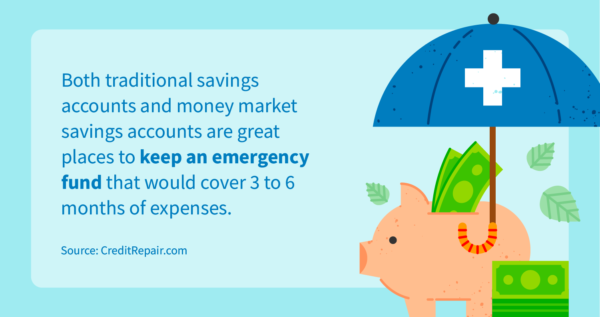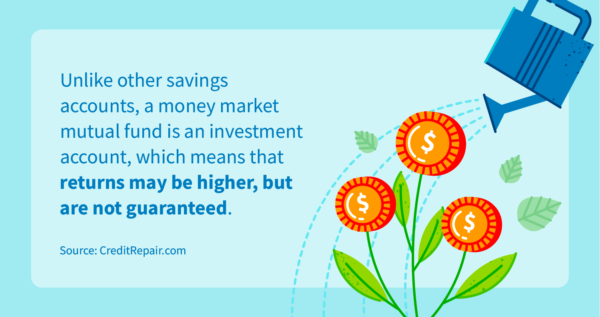
Disclosure regarding our editorial content standards.
We’ve all got financial goals, like going on a dream vacation or buying a home. To get there, we need places to keep money while we continue to save—maybe even a place where that money can grow a bit.
So, where are the best places to save money? That depends a lot on what you’re saving for and how long you’re planning to save. There are many places to store your money: a savings account, certificate of deposit, money market fund or retirement account, for instance.
We’ve created a table to help you figure out where the best place for your money could be. And keep reading for more information about eight different ways to stash your savings.
| Best places to keep your savings | ||
|---|---|---|
| Goal type | Examples | Accounts |
| Short term | Home repairs, small vacation or car down payment | Savings account or money market account |
| Medium-term | Large wedding, house down payment or home improvement project | High-yield savings account, certificate of deposit or money market fund |
| Long-term | Retirement or college fund | Investment account like a 401(k), IRA or 529 |
Now that you know what kind of account you may be looking for, scroll down for more details.
1. Traditional savings account
A savings account is what most people think of when they’re planning to save money. Both banks and credit unions offer savings accounts, which offer slightly higher interest rates than checking accounts.
These savings accounts are incredibly useful since they’re easy to access for both deposits and withdrawals. That makes them an ideal place to store an emergency fund that you may need at a moment’s notice.
On the other hand, traditional savings accounts often have a fairly low annual percentage yield (APY)—somewhere between 0.02 percent and 0.20 percent is common. If you kept $1,000 in a savings account with a 0.02 percent APY, it would only earn you 20 cents each year in interest.
Still, these accounts have little risk since they’re backed by government insurance, so they’re a great place to keep money without fear of losing anything.
Advantages: Easy to open and easy to access
Disadvantages: Generally low interest rates
Best for: Emergency fund, short-term savings goals
2. Money market savings account
A money market savings account functions similarly to a traditional savings account, but it often provides higher interest rates for accounts with higher balances. Additionally, some money market savings accounts also provide features typically associated with checking accounts, like a debit card.
Like traditional savings accounts, money market savings accounts are backed by the Federal Deposit Insurance Corporation (FDIC), which protects your account in case your bank or credit union fails.

Since money market savings accounts are easy to access, they’re still great for short-term savings goals or money you may need in a pinch. For those with higher savings balances, a money market savings account could make sense if your bank or credit union offers a higher APY for a significant deposit.
Advantages: All the advantages of a traditional savings account with potentially higher interest rates
Disadvantages: Often only benefits those with larger account balances
Best for: Emergency fund, short-term savings goals
3. High-yield savings account
A high-yield savings account is exactly what it sounds like: a traditional savings account with a higher annual percentage yield. Typically, savings accounts with higher APY are offered by online-only banks. Since these banks don’t maintain local branches or ATMs, they have fewer expenses. These savings get passed on to their customers in the form of a higher interest rate on savings accounts.
While interest rates vary over time, high-yield savings accounts have offered interest rates as high as 1.5 percent in the past few years. While this interest rate isn’t going to make your money grow at an astronomical rate, it can help offset inflation while you leave your money parked.
One downside of high-yield savings accounts is that online-only banks may not be able to let you withdraw your money as quickly since there are no branches to visit. For that reason, you may want to reconsider putting your emergency fund in one of these accounts.
Advantages: Higher interest rates
Disadvantages: Online-only banks have no physical branches if you need banking services
Best for: Medium-term savings goals
4. Certificate of deposit (CD)
A certificate of deposit (CD) is another type of savings account offered by banks, though they function differently from typical savings accounts. A CD usually provides a higher interest rate than a savings account, but you must agree to keep your money in the account for a fixed period of time before withdrawing it. Typically, CDs have early withdrawal penalties—or you simply don’t earn interest if you pull your money out early.
In essence, a CD is a less flexible account with a greater reward: if you know you don’t need a sum of money for a period of time, placing it in a CD offers some return with very little risk. While CD interest rates vary greatly over time, they are often anywhere between 0.25 percent and 2.25 percent. Usually, you’ll earn a higher interest rate for a larger deposit or a longer time frame.
Since a CD has early withdrawal penalties, it’s best for money that you know you won’t need for a while but that you don’t want to risk by investing. For example, if you’re planning to buy a new car in a few years, you could save the down payment in a CD where it can grow modestly.
Advantages: Competitive interest rates with little risk
Disadvantages: If you need the money early, you may pay a withdrawal penalty
Best for: Specific savings goals on a set timeline
5. Money market mutual fund
A money market mutual fund is a form of investment account that specializes in low-risk assets, like U.S. Treasury bonds. Although its name sounds similar to a money market savings account, a money market mutual fund is operated by an investment firm rather than a bank. As a result, a money market mutual fund involves more risk than a typical savings account.
The upside of a money market mutual fund is that it generally offers higher returns—however, those returns are not guaranteed. Most investment firms offer money market mutual funds, which are considered investment savings accounts. These accounts offer slightly better returns than savings accounts but are fairly liquid, meaning you can access the money when you need to.

If you’re considering using a money market mutual fund, make sure you look into the tax implications as well as the fee structure for the brokerage you’re working with. Additionally, consider how easily you’ll be able to access the money in your mutual fund account.
Advantages: Offers a larger return on investment and some flexibility
Disadvantages: All investment accounts involve some risk
Best for: Medium-term savings goals
6. 401(k) or Individual Retirement Account (IRA)
Both 401(k) accounts and individual retirement accounts (IRAs) are tax-advantaged investment accounts aimed at saving for retirement. These accounts typically offer significantly higher rates of return than cash, but the risk involved and the likely returns vary based on the specific investments.
While both of these accounts are designed for retirement savings, they are not identical. A 401(k) is usually offered by an employer, whereas anyone can open an IRA with an investment firm. Both accounts enable investors to choose their asset mix—which means a combination of stocks, bonds or other investments. Additionally, these accounts have some tax advantages, helping to reduce your tax burden either when you make deposits or when you withdraw money during retirement.
Often, younger people will have a larger percentage of their retirement savings in stocks, which generally provide higher returns—but with more risk. On the other hand, older people usually keep a higher percentage of their retirement investments in bonds, which offer a smaller return but with much less risk, which keeps their accounts stable as they approach retirement.
Before opening an investment account, consider consulting with a financial advisor, who can guide you on the best approach to your retirement, optimizing for fee structures, asset mix and taxes.
Advantages: Offers a significantly higher return on the road to retirement
Disadvantages: All investment accounts involve some risk
Best for: Retirement savings
7. 529 savings plan
A 529 savings plan is a tax-advantaged savings account that enables parents to invest money toward their children’s college education. As with other forms of investments, you are able to choose what assets you want to invest in, and your account will generate corresponding investment returns.
While these accounts involve risk, they also have significant benefits, since the money you invest may reduce your tax burden. Additionally, your children can withdraw the money tax-free (up to $10,000 each year) to pay for educational expenses.

These investments tend to be most successful over the long term, since they involve compounding interest—in other words, the money they generate is reinvested, enabling you to grow your money even faster. While there are no guarantees with investment accounts, they are generally helpful in producing the money needed to pay for a pricey college education.
Advantages: Tax benefits and higher investment returns
Disadvantages: All investment accounts involve some risk, and not all states provide tax incentives for deposits into 529 savings plans
Best for: College education savings
8. Health savings account
A health savings account (HSA) is a tax-advantaged savings account provided with high-deductible insurance plans. This type of account enables you to put pre-tax income into an account that can be used to pay for qualified medical expenses, like doctor’s visits, medication or eyeglasses.
If you know you’ll have a certain amount of medical spending in a given year, a health savings account can be an excellent choice for two reasons. First, you won’t be taxed on the money you put in your HSA, so your overall spending will be lower. Second, by planning ahead for your expenses, you’re making a savvy financial choice that will benefit your spending and budget across the board.
Ultimately, a health savings account is a great option for anyone with ongoing health expenses that would otherwise get paid for with post-tax money.
Advantages: Tax benefits for medical spending
Disadvantages: Money can only be used for health-related expenses
Best for: Ongoing medical costs
What’s the best way to start saving?
There’s no best way to save money, but it’s definitely true that building a habit of saving money will benefit you in a variety of ways. The simplest way to start is this: save.
As you consider your entire financial picture, you may have many different goals. Here are a few to consider:
- Start an emergency fund: Having three to six months’ worth of expenses in a savings account can be helpful to pay for unexpected expenses or to weather the financial storm in the case of sudden unemployment. You can build an emergency fund by putting aside a little bit every month into your savings account.
- Save for a vacation, wedding, car or house: Having financial goals is a great motivator to save. Set a specific savings goal as well as a date you’d like to reach it—that way you’ll know exactly how much to save every month.
- Make a plan for retirement: Getting started early with retirement can make a huge difference in your investment account when you turn 65. A 25-year-old who saves $1,000 each month will have $1.4 million in their retirement account with 5 percent returns, whereas someone who waits until age 45 to make the same contribution will have less than $400,000.
While you make a plan for savings, also think about your current debts. If you have high-interest debts—from a credit card or loan, for example—it may be in your best interest to prioritize making a plan to pay them off. A consolidation loan could help you get your debt under control, which may also help your credit score.
If you’re struggling with debt and need help reviewing your credit report, consider working with CreditRepair.com, which focuses on helping clients work on their credit reports to meet their credit goals.
Note: The information provided on CreditRepair.com does not, and is not intended to, act as legal, financial or credit advice; instead, it is for general informational purposes only.
Questions about credit repair?
Chat with an expert: 1-800-255-0263






